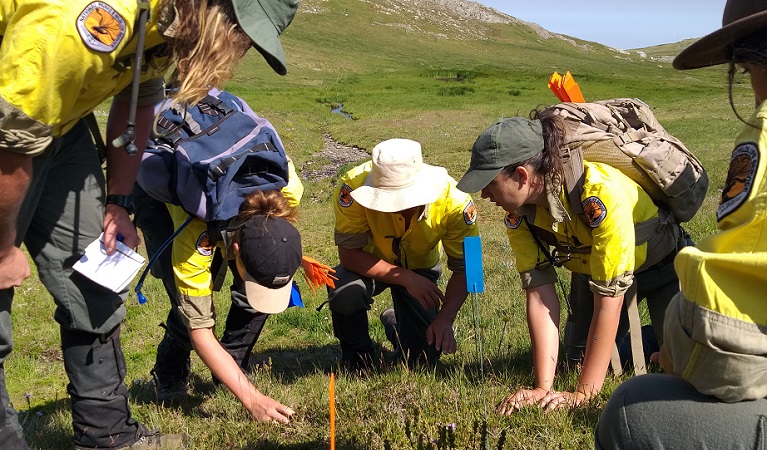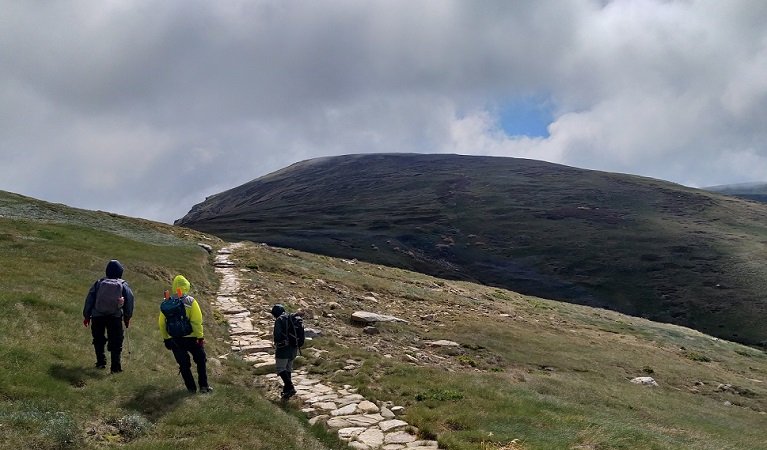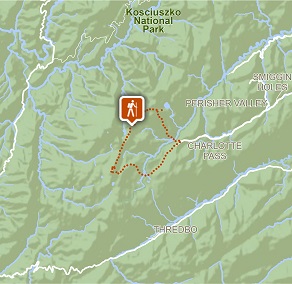Hunting mouse-ear hawkweed
Thredbo-Perisher area in Kosciuszko National Park
Overview
Help eradicate mouse-ear hawkweed in Kosciuszko National Park. Volunteers have done invaluable work searching for it since it was first found in the area in 2015. Join the fight in a week-long camp.
- Work
- Bush regeneration, weed and pest management
- When
Currently not accepting applications.
- Grade
- Medium. Suitable for adults and teens 18 years and over with a good level of physical fitness. You'll be walking around 4km a day, over natural rough and uneven terrain (no paths), with moderate slopes on uneven surfaces.
- Entry fees
- Park entry fees apply
Like orange hawkweed, mouse-ear hawkweed is a serious threat to the Australian Alps and surrounding environments, including productive farmland. It's known to out-compete native and pastoral plants and can create a monoculture.
Volunteers are instrumental in helping us protect sensitive alpine environments from mouse-ear hawkweed invasion. We’ll train you in hawkweed identification and vegetation monitoring methods. You’ll help us find the plants so they can be treated. Week-long surveys coincide with the peak hawkweed flowering period each year, when mouse-ear hawkweed is easier to detect.
Surveys are conducted in some of the most scenic areas of Kosciuszko National Park, including Main Range, Mount Twynam and Blue Lake. A maximum of 4 volunteers do this work a week. You’ll stay in free shared accommodation in Perisher Valley. NPWS will supply the basics for breakfast and lunch. Volunteers will need to bring food and prepare their own evening meals.
Find out more about volunteering with us
Saving Our Species program
Australia is home to more than 500,000 animal and plant species, many of which are found nowhere else in the world. Saving our Species is a statewide conservation program that addresses the growing number of Australian animals and Australian native plants facing extinction.

Park info
- in the Thredbo-Perisher area of Kosciuszko National Park in the Snowy Mountains region
- The Thredbo-Perisher area is open all year, but some roads and trails may close due to weather conditions or park management issues. Kosciuszko Road is closed between Perisher and Charlotte Pass in winter (June to October long weekends).
-
Park entry fees apply on Alpine Way and Kosciuszko Road
Winter (June to October long weekends): $29 per vehicle per day (24hrs from purchase); motorcycles $12; bus passengers $11.45 per adult, $3.60 per child per day. Find out more about the winter entry surcharge.
Rest of Year: $17 per vehicle per day (24hrs); motorcycles $7; bus passengers $6.60 per adult, $2.20 per child per day.
Passes: Day passes, multi-day passes and annual All Parks Pass available from NPWS visitor centres, local agents and operating vehicle entry stations. Single and Multi-Day passes are also available via the Park'nPay app. Short Breaks Pass: $68 for 5 days park entry at price of 4 days (not valid winter).
Read our Annual Pass FAQs for information.
Buy annual pass
What's nearby:
Things to do (74)
- 4WD touring (1)
- Adventure sports (3)
- Birdwatching and wildlife encounters (3)
- Canoeing/paddling (3)
- Cycling (13)
- Fishing (9)
- Historic heritage (7)
- Horse riding (2)
- Other experiences (2)
- Picnics and barbecues (5)
- Road trips and car/bus tours (1)
- Sightseeing (15)
- Snow sports (26)
- Swimming (1)
- Visitor centres (1)
- Walking (30)
- Wildflowers (seasonal) (11)




